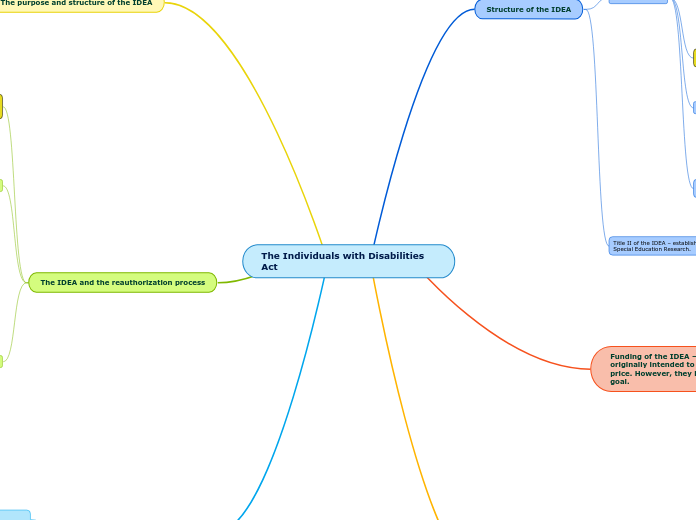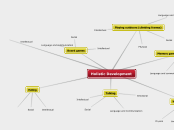The Individuals with Disabilities Act
Monitoring and Enforcing the IDEA
This was also a big step! Previously, it was difficult for SPED Laws to be enforced.
The Office of Special Education Programs (OSEP) is responsible for
Providing technical assistance to the states.
Monitoring and enforcing the provisions of the law
Conducting many of the activities authorized by Part D of IDEA
Writing regulations that implement the IDEA.
The IDEA and the reauthorization process
The Individuals with Disabilities Improvement Act of 2004
Highly Qualified Teachers
Early Intervening Services
Eligibility
Attorney’s Fees
Disciplining Students in Special Educations
Stay-put provision.
Behaviors that can lead to a 45-day disciplinary removal.
Manifestation determination
The IEP
IEPs for Transfer Students
3-year IEPs
Changes in the IEP modification Process
Changes in the IEP document
Changes in the IEP development process
The IDEA Amendments of 1997
Charter Schools
Special education and adult inmates
Attorney’s fees
Dispute resolution
The manifestation determination
Discipling students in special education
The individualized education program.
Amendments to the IDEA – numerous changes were made since the original EAHCA in 1975. Some were major, some were minor.
The purpose and structure of the IDEA
Purpose of the IDEA – addressed issues of EAHCA like children being excluded from schools, children did not receive an appropriate education for their needs, children were not diagnosed, and schools lacked adequate resources.
Infants and Toddlers – part C of IDEA was passed in 1997. This amendment provides grants to states to provide services to children with disability birth through age 2.
Purpose was to enhance development to minimize their delay, reduce cost of later intensive interventions, minimize the likelihood of institutionalization, enhance the family’s ability to meet needs.
Age Requirements – services are required between the ages of 3 and 21. It is required to identify and evaluate children from birth to 21.
Services are available to all eligible students because of Part C!
Categories of disabilities • autism; • deaf-blindness; • deafness; • emotional disturbance; • hearing impairment; • intellectual disability; • multiple disabilities; • orthopedic impairment; • other health impairment; • specific learning disability; • speech or language impairment; • traumatic brain injury; or • visual impairment (including blindness).
Who is protected? – those determined eligible for services by the MDT on an individual basis.
The development of IDEA – advocacy, litigation, and legislation went a lot way.
The passage of the IDEA
Education for All Handicapped Children Act of 1975 (EAHCA) addressed issues seen from the previous acts.
This was a HUGE step for children with disabilities! All of these cases combined made a huge impact on the abilities.
Early court rulings and legislation
Mills v. Board in 1972
Park v. Pennsylvania in 1972
resulted in access to public education for students with disabilities, basic procedural rights, and amendments to the EHA.
Education of the Handicapped Act of 1970 (EHA)
Not all states accepted and followed the act.
Amendments in 1974 are full educational opportunities, procedural safeguards, LRE.
Elementary and Secondary Education Act of 1965 (ESEA)
Subtopic
Funding of the IDEA – Federal funds were originally intended to cover 40% of the price. However, they have never met this goal.
This is why it is difficult for schools to offer the best of the best services. Schools are sometimes hesitant to recommend students attend a private school because they would have to fund it.
Many schhol have to pay for their own services
Structure of the IDEA
Title II of the IDEA – established the National Center on Special Education Research.
Title I of the IDEA
Part D – national activities to improve education of children with disabilities.
Subpart 3 – Supports to Improve Results for Children with Disabilities
Subpart 2 – Personnel Preparation, Technical Assistance, Model Demonstration Projects, and Dissemination of Information.
MARZANO BABY!
Swift, IRIS
Subpart 1 – State Personnel Development Grants
Part C – infants and toddlers with disabilities
Overseen by the Department of Health and Human Service
Can bill medicaid
Individualized Family Service Plan - coaching model
Less strict
TItle 1 Schools, like Madison School District, Sugar Salem School District.
Walk to read, read 180, system 44
Part B – assistance for education of all children with disabilities
Parent Participation – parents must be involved in the evaluation, IEP meetings, and placement decisions.
Personnel Development – the kind and number of personnel needed to meet the goals of the IDEA.
Technology-Related Assistance – offers federal grants to states to provide AT.
Procedural Safeguards – ensures that parents are equal participants (informed consent).
LRE – Least Restrictive Environment
FAPE – Free and Appropriate Education
Identification and Evaluation – protection in evaluation procedures
Zero Reject – all students who are eligible are entitled to services.
Overseen by the Department of Education
Can bill Medicaid
Individualized Education Plan - parents are on the team, but less involved than in Part C
More strict
This department wrote the regulations
Part A – general provisions and definitions









